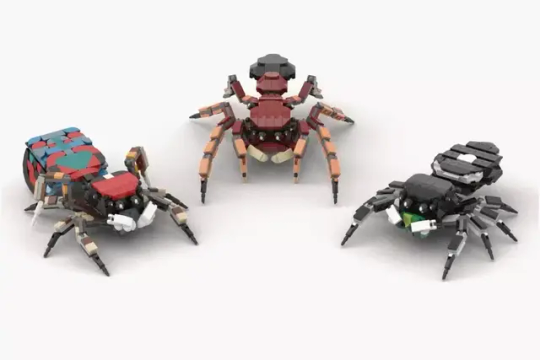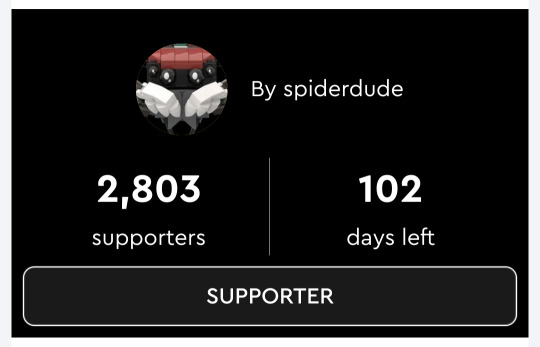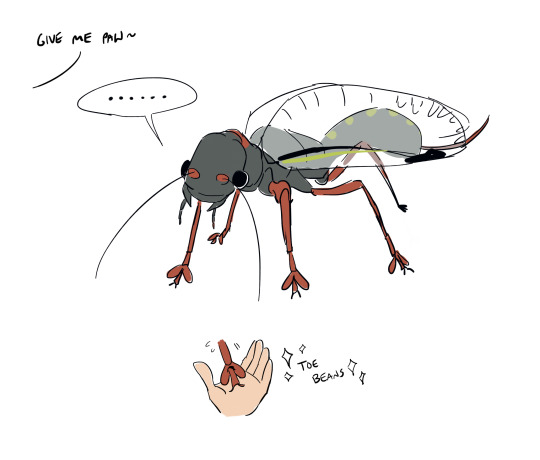Heyo, I'm Kade (they/them) and I love insects, arachnids and everything scientifically adjacent to them. I will talk a lot about them on this blog going forward, but since I am no entomologist, some claims might be false. So feel free to correct me whenever something I write isn't true or if my sources aren't accurate. Now have fun looking at and reading about all the great creatures on this planet!
Don't wanna be here? Send us removal request.
Text
Dragonflies rule (also taxonomy is confusing)
This was the week of dragonflies appearently, couldn't ID all of them, but who cares, they were all absolutely beautiful. So have yet another photo dump!








All photos taken by me in saxony, germany
I don't think I've covered this yet, but dragonflies are, like, a whole seperate order of flying insects compared to neoptera which covers a majority of insects. To get to that, we might wanna take a deepdive into the taxodermy of insects. So if you were here just for the dragonfly pics, there won't be more. This will now be a biology rant.
There are three big subclasses of insects: first, we have Archaeognatha (or jumping bristletails), very primitive and adorable. Also they can't smell anything appearently, since they lack the receptor (Orco) for it. They mostly love moisture, but have adapted to other habitats.
Then there are the better known Zygentoma, with species such as silverfish or firebrats. Very fun little critters, and they just love humidity. Some species live as nest associates like Atelura formicaria, others are synanthropes and inhabit cellars, or even ovens like the firebrat.
Both of these subclasses are wingless, so obviously the last subclass of insects are the flying insects (Pterygota). They make up 99.9% of all knows species of insects.
And this is where this all gets kinda messy, I'll try my best to somehow explain this.
So there are three big terms we gotta keep in mind; Mayflies (Ephemeroptera), Dragonflies/Damselflies (Odonata [I will refer to them as only dragonflies to make this more readable]) and Neoptera. Here in germany we took the easy path and just said "oh yeah, these are just three seperate superorders, simple", but oh no, it's not as easy as that.
It's pretty simple to differenciate mayflies from neoptera as they both lack the possibility to flex their wings over their abdomen and also resemble the other subclasses in their cerci, the tail-like appendages at the end of their abdomen.
But then dragonflies ruin everything. They too can't flex their wings over their abdomen, so one could say "hey, why not make mayflies and dragonflies one category and neoptera the other?". And you would be a fool to think that isn't the case already.
Palaeoptera is a devision of winged insects, containing dragonflies and mayflies. This is where this rant should be over, but no, there just had to be one more thing!
Metapterygota is a clade of winged insects, containing dragonflies and neoptera. This so called taxonomal branch is referring to winged insects that lack the subimago state after their larvae state. The subimago state is, of course, found in mayflies.
So in conclusion, dragonflies do not resemble neoptera in that they cannot flex their wings over their abdomen, and they do also do not resemble mayflies in that they lack the subimago state before maturing.
This conclusion is way less convoluded than the journey it took to get there, but that's just how biology is sometimes. The most tedious research makes it possible to differenciate even the most overlooked creatures from one another using very simple metrics. And I gotta say, thank god I could just read my way through a bunch of studies and articles already containing the knowledge some dedicated entomologists already got by doing research for decades. Thank you, y'all are really cool people.
16 notes
·
View notes
Text
Would you look at that curious guy! Oil Beetle!


I love oil beetles, saw one twice last year while at work, so I didn't have enough time for a photoshoot. But not this time, this one was walking around in the garden. Great fella, hope to see more of them. They are harmless, just try to not scare them too much. You are still way bigger than them.
All pictures and videos taken by me in saxony, germany
71 notes
·
View notes
Text
He cried for uppies…
and he got them. All hail King Oreo! 👑
10 notes
·
View notes
Text
I FINALLY GOT SOMETHING OMG! She was doing this on purpose, I swear! I basically sat in one spot for half an hour and that little gremlin flew circles around me, flying back and forth whenever I was close to actually taking a picture. After what felt like an hour she finally sat down for a photo shoot. AT LAST, I HAVE BEFRIENDED YOU!!


Okay in all seriousness, great creature. Worth the stealth, even if the photos turned out kinda blurry. It was funny.
Another sunny day, another photo dump from the garden~
First, this large bee-fly (bombylius major) gave me a very hard time getting any photos, so I only have this very low res clip my phone takes automatically. She was too fast for me.
Next I tried to get a good photo of this curious little fella, who turned out to be a zyginella pulchra, a cute little member of the family of leafhoppers. Her german common name is "Diadem-Blattzikade", roughly translating to "tiara-leafcicada" and I am so in love with this name

And last, I stumbled upon this species of sciaridae I couldn't quite pin down the exact species of. I really loved how their antenna looked, but the internet was once again more busy telling me about their role as pests and how to get rid of them. As if I cared about that.

All photos taken by me in saxony, germany
25 notes
·
View notes
Text
Another sunny day, another photo dump from the garden~
First, this large bee-fly (bombylius major) gave me a very hard time getting any photos, so I only have this very low res clip my phone takes automatically. She was too fast for me.
Next I tried to get a good photo of this curious little fella, who turned out to be a zyginella pulchra, a cute little member of the family of leafhoppers. Her german common name is "Diadem-Blattzikade", roughly translating to "tiara-leafcicada" and I am so in love with this name

And last, I stumbled upon this species of sciaridae I couldn't quite pin down the exact species of. I really loved how their antenna looked, but the internet was once again more busy telling me about their role as pests and how to get rid of them. As if I cared about that.

All photos taken by me in saxony, germany
25 notes
·
View notes
Text

if you like lego + jumping spiders, you should vote on this user created lego product idea! if it gets 10k votes it has the chance to become a real set 🕷️🕷️🕷️

VOTE NOW!!!
11K notes
·
View notes
Text
Okay so I was looking at that interesting little creature sitting in the window, which turned out to be some species from the Tenthredinidae family

now, this is the outside view. But since I work here, I could take some pictures of the abdomen and.. oh my god it has those paw-like feet!



Look at the lil critter with the toe beans I am so in love right now, I hope it decides to come in and stay because it will almost certainly freeze to death tonight if I does not move from that window😭
All pictures taken by me in saxony, germany
17 notes
·
View notes
Text


i learned some snakeflies have bilobed tarsi (similar to chrysomelid leaf beetles) and it makes them look like they've got cute little paws :3 photo is inocellia sinensis
2K notes
·
View notes
Text
If we talk true bugs only, there really is no other option than my dear friend Graphosoma italicum, not only eye-candy but also friend-shaped^-^ (can you tell that I love heteroptera already?)

If you count all the little critters crawling around, I gotta say that Cosmoderus femoralis will never be beaten in that group of specimen for how goofy it looks, like a toy made out of chestnuts. Also look at their eyes, how is it so cute😭

Now, if literally ALL insects are considered bugs, I will have to be very boring and will say that hummingbird moths (top picture) and rosy maple moths (bottom picture) are perfect. Everybody loves them and there is a darn good reason for that.


HAPPY FUNKY BUG FRIDAYYY
bugblr tell me your favourite bugs with possible photos!!
my asks are always open for cool bugs or other stuff ([[[[[[[[[[){
56 notes
·
View notes
Text



Found this silly little cutie sitting on a fire hydrant, probably scared her very much, but I just couldn't resist letting her crawl on my hand for just a few seconds. But I mean be real, you wouldn't be able to resist those eyes either.
All photos taken by me in Saxony, Germany
1 note
·
View note
Text


Lady beetles are finally back in the wild and I couldn't be happier😭 Like how is even possible to be this friend-shaped? When did society stop appreciating the beauty of common insects like this? Like are we stupid or something?
Both photos were taken by me in Saxony, Germany earlier this month
23 notes
·
View notes
Text

red wood ant (formica rufa) I took a photo of last week, what a gorgeous little critter!
3 notes
·
View notes
Text






The local fauna is finally full of arthropods again, oh how I missed you! Now I will definitly need a camera for summer, my phone is just not good enough for any of this.
all photos taken in saxony, germany by me
10 notes
·
View notes
Text


This little weevil was sun bathing on my fence when I came home today, so adorable. Instantly made me happy, can't wait for spring to finally be here. I need more little guys.
21 notes
·
View notes
Text

This is Gasteracantha cancriformis, the spinybacked orbweaver.
I haven't yet talked about spiders on this blog, even though there is so much to talk about. So let's start with this one.
As my bio states, I am no scientist, I just love arthropods and want to learn about them. So this next bit might not be uncommon for spiders.
Anyway, appearantly there is no data on how this species mates in the wild, so we only know it from lab tests. And what they found out was that the female will weave the male into her net and then proceeds to mate with him. The male obviously never leaves the net after that. The female will go on to produce eggs, after that she will also tragically pass away.
Oh also they somehow mate for 35 minutes. And even after that the female will come back multiple times to mate some more.
If you ever come across one, don't worry, their poison is harmless. So let them crawl a bit, maybe pet them, they look soft. But don't occupy them for too long as their life is very short and they really need to mate.
0 notes
Text

This is Libelloideus coccajus, also known as owly sulphur.
Even though they look quite similar to them, owly sulphurs aren't butterflies or moths. They are owlflies, a cute family of neoptera that have attributes of both dragonflies and butterflies.
The reason i chose this specific owlfly is because it might be the most tragic little friend out there. Their antennas are perfect to sense prey when it's sunny, but once the sun fades away, so does any chance of them catching prey. If this happens, the owly sulphur does not fly away. It stays and waits for another sun. You could gently cut the blade of grass it's sitting on and pick it up, it also wont fly away.
For some, the sun will rise again. Those who aren't so lucky will starve on the very blade of grass they will hold on for the rest of their life. What a brave, yet fragile hunter.
If you live anywhere in southwest europe and happen so see an owly sulphur, be sure to take a photo, they are quite rare. And also beautiful, but that is expected since it is, indeed, an insect.
1 note
·
View note

